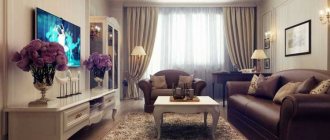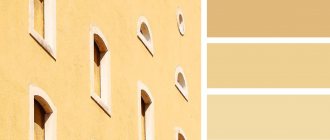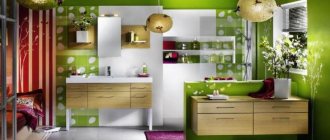Features of color and its shades
In nature, brown is obtained as a result of the solidification of liquids of yellow shades. Because of this, it is sometimes called dark yellow. The similarity to mixed colors, such as bronze, chestnut and coffee, is explained by the large number of different pigments in their composition. In fashion, brown has always been contrasted with bright, rich tones, and therefore has received a reputation for being “grown-up and respectable.” This color scheme also includes many shades. They got their names due to the prevalence of brown in nature and everyday life. These include wheat, brown, rust, copper, dark beige, brown, chocolate, as well as khaki, sepia and the color of withered leaves. Some tones have a peculiar tint. Dark burgundy is also considered a shade of brown, but this does not apply to burgundy in general, which in principle is not mixed, but is close directly to red.
Pros and cons of mixing it yourself
It is recommended to buy ready-made brown paint if you are not confident in the quality of mixing it yourself. When using acrylic paints in particular, there may be problems with application to clothing or canvas - they will look different there. This is influenced by some components and features of raw materials from a particular manufacturer. If you need to paint a lot of walls, there are two options - buying ready-made paint or making it to order. It is not possible to make two mixtures of absolutely identical shades on your own - you need special equipment. In a simpler situation, experimentation should not be avoided. You can fully realize your ideas about shades. There will be some negative aspects in this process. Since the entire volume of paint is calculated initially, “misses” are possible. In addition, tinting takes a lot of effort. The problem will also be the synthesis of rich tones. Well, the main disadvantage can be considered the high tendency to fade, characteristic of such solutions.
However, there are many advantages:
- saving;
- wide selection of paints for cooking;
- creating unique shades and adjusting them;
- mixing near the work site.
Rules for mixing tones
There are several systems and models that determine the interaction and similarity of colors. The science of various aspects of the compatibility of shades and their use in art is called coloristics. One of its foundations is the color wheel, including intermediate colors. To synthesize different tones, 3 basic colors are used: red, yellow and blue. A special role is also given to achromatic colors - black and white. Mixing rules are built around these features. You need to mix watercolor, acrylic, gouache, oil, water-based and construction paints on a white palette - this is how the resulting shade is clearly visible. Instead, you can also use a white earthenware plate, and sometimes even plastic dishes, white cardboard or thick paper. There are 4 basic rules for color mixing:
- There are achromatic tones (white, gray, black) and colored (all others). In the second category, they differ in saturation, depth, brightness, lightness and hue.
- Mixing can be done mechanically (by stirring) and optically (by placing strokes on top of each other).
- When merging 2 of the main tones, you will get intermediate ones between them on the color wheel.
- When you mix 2 opposite colors on a circle, you get a composite that is unlike them.
How to get dark brown color
It’s easy to get the desired result: add a little black pigment to red, orange or yellow. Brown can easily be given different shades: you need to take yellow, blue and red as a basis, and then add other colors. For example, red helps create a warm tone with a hint of rust, while blue helps ensure the final result has depth and punch. Saturation can be achieved by combining different proportions of yellow, blue and red according to the following scheme:
- Mustard can be obtained by combining red, yellow and black with a drop of green.
- Dark brown will be achieved by mixing red, yellow, white and black.
- Red-brown (known as marsala, similar to dark pink) should be obtained by mixing two shades: chocolate and red in large quantities.
Basic colors to get brown
Brown is made by mixing several pigments. Experienced specialists can perfectly calculate the required proportions of the three primary colors. However, in practice it is more convenient to mix 2 colors at a time, and gradually. Classic combinations for synthesizing a brown tone are combinations of red and green, orange and blue, and violet and yellow. In each case, one paint is used as a base, and the other gradually forms the desired classic shade of brown. So, you need to add red to green, blue to orange, and yellow to purple. The amount of pigment added usually needs to be much less. Other proportions of fusion will give different, dissimilar shades of brown and other composite colors. Brown can also be obtained by mixing in small quantities all the colors of the rainbow. Important! You can improve the color using special dyes.
Green with red
This is one of the combinations for creating dirty tones. If you don’t have green on hand, you will have to use the three primary colors, mixing blue and yellow to the desired tone. This combination, among other things, allows you to select different shades of green. This, in turn, will add options to the final result from mixing red with green. What to add to what is decided individually. However, it would be more correct to pour red paint into a container with green, exactly until the shade and brightness become as desired. Whatever the proportion turns out to be in the end, the resulting shades will come out warm. It is worth experimenting with the ingredients: choose green in a dirty shade, for example, camouflage, or light, light green, and similarly in the case of red. Generally, the darker the red and green paints, the better.
Orange with blue
In this case, if necessary, the entire three basic tones are also used: if you need to make orange yourself, then red and yellow are mixed. The first should then account for 9/10, and the second, respectively, 1/10. This ratio can be varied, but a dark shade is required. The color of the solution can be made “intermediate” between orange and red. Blue is added to this mixture or to the finished orange paint. The required volume is selected individually, but in the range from 5 to 10 units. by 90-95 units. orange component, depending on the desired lightness and the original appearance of both ingredients. If the blue composition is used in the recommended amount, then it remains possible to adjust the brightness of the mixture or add cyanosis. You can look at the final color only after the film has dried. One way or another, it will come out lighter than the original version. It won't hurt to do preliminary tests on some surface.
Purple with yellow
Another way to get brown is to mix yellow with purple. In the absence of the second, a mixture of blue and red is made. Purple leans more toward blue, so more blue paint is needed to create a “true” color. Violet and red are adjacent on the spectral circle, but are at opposite ends of the visible spectrum. With equal proportions or a preponderance towards red, the result will be purple. It is also suitable for subsequent mixing with yellow. The latter, one way or another, is used to add darker pigment. Yellowness must be added gradually so as not to make the mixture too light. The composition will need to be constantly stirred, otherwise you may miss the moment when yellow is no longer needed. Next you will need to do a shade test on a hard surface. Decisions are then made based on the color of the surface layer.
The resulting paint is suitable for use on both mineral and metal surfaces.
What colors make brown?
You can even make brown from plasticine or felt-tip pen ink, but the best result will be achieved when using gouache. To create brown paint, you need to prepare yellow, blue, red, green, black and white - their various combinations will be involved in obtaining a new tone.
There are several methods that allow you to make the desired color from other paints. It is necessary to take classic, pure tones without impurities. There are several options - basic, three-color and intermediate, and artists also know about a number of additional techniques for creating brown.
Using primary colors
This method is the simplest; it only requires accuracy and high-quality colors.
Green with red
Even schoolchildren know from art lessons that you can get brown if you add red to green. When green is not available, you can mix yellow and blue. The latter are taken in equal proportions to create a “classic” green tone, although individual desires can be taken into account. To get a more transparent brown, you can use a little more yellow.
It is important to introduce red into green, but not vice versa. Add it drop by drop so as not to spoil the new tone, turning it into taupe, rusty or brick. Green will serve as the main color here, but red makes the brown tone warmer.
Orange with blue
First you need to make a bright orange color (if it is not ready-made). To do this, take red and add yellow to it little by little. The amount of yellow should not be large; 10-15% of the total mass of the final color is enough. The final shade should be dark orange; a light tone is not suitable for making brown.
Next, blue paint is added to the orange - about 7% of the total volume. After introducing each drop, stir the color well, adjusting the richness of the brown.
Purple with yellow
An intermediate method of producing brown involves creating the color violet and combining it with yellow. First, take equal parts red and blue colors. As a result of mixing them, a noble violet is obtained. Next, they begin to gradually add yellow color, which will lighten the purple. Brown in this case will not be dark, but will have a warm, pleasant glow. Adding new portions of purple acts in the opposite way - it “cools” the shade. Using this technique, adding a large volume of yellow paint produces an ocher color.
Additional Methods
Combining dark gray with orange also produces a brown color, although it will remain cold even with the introduction of an increased amount of orange. Brown is also obtained by mixing green, purple and orange, however, such a multi-step technique is complex.
Getting a dark brown color
In any of the above options, introducing additional portions of dark color helps to achieve a dark brown tone. We are talking about blue, green and purple colors. However, the shades of brown will be different, because each component plays its role in creating them.
There is another simple way to obtain a dark brown color from acrylic, oil or any other paints. A little black paint is dripped into the finished brown. But you need to work with it with extreme caution, otherwise the color will turn dirty black. Professionals even first mix black with a small amount of white, after which they prepare brown on its basis. This will make the black softer and give a more pleasant dark brown tone.
Dark chocolate color can be obtained like this:
- combine yellow and blue to get dark green,
- separately mix red and a little yellow to make orange,
- mix dark green and a drop of orange until you get the color of grass,
- mix the prepared herbal color with red to get a chocolate color,
- To make dark chocolate, add a drop of black paint.
For a milky chocolate color add white, for a golden chocolate color add yellow.
Light brown color
A light brown tone can be easily created by diluting regular brown with white paint. The more intense the bleaching, the lighter the color. It is important not to overdo it here, because brown is a warm shade, and white “cools” it. Usually 1-5% white of the total paint mass is enough to achieve a sufficient degree of lightening. You can also get light brown if you initially add more yellow, although it is quite difficult to calculate the proportions so accurately.
Medium brown color
To obtain a brown of medium intensity, mix yellow and blue in equal parts, then add 20% of red by weight of the mixture. Next, adjust the depth of the shade by adding black or white, depending on the need.
Red-brown shade
The secret to creating brown with a hint of red is adding more red to it. When you add it to green, you first get regular brown, then bring it to the desired shade. The intensity will depend on the volume of the color. In addition, the desired color is created by mixing red, blue and yellow. The easiest way to “touch up” brown is to add a drop of red to the finished brown color.
Taupe color
This shade is made by combining orange and blue and then adding black paint. Also, a grayish or coffee color is obtained by mixing violet (purple) and orange with the introduction of black.
Methods for obtaining shades of brown
To obtain warm shades, add yellow or red to brown paint. You should not pour large portions at once; gradual stirring is necessary. Light and warm shades of brown allow you to paint elements such as reflected light, earth, brick and wood surfaces. If the tone is too warm, the balance can be restored with blue paint. You should initially add only a blue tone to create a dark and calm shade. The color can be varied with white and colored paints. To obtain dark brown shades you will need black pigment. No more than a few percent of the total volume of the mixture should be added. An excess of black color is very difficult to compensate for, unless by increasing the mass of brown several times, and this is not always acceptable. Adding too much white or water to eliminate blackness will only make the mixture worse.
Features of obtaining shades
Let's now consider various variations of the classic brown color scheme. There are a great many of them. Let's focus on the 8 main ones. To obtain this you will need additional tint halftones.
Red-brown
Take red and lemon paint. Scarlet color - one hundred percent more. Add blue. At the end we add white. Literally 1%. The result is a red-brown undertone.
Dark brown
Red, lemon, blue are mixed in equal proportions. 1:1:1. At the end - literally a couple of drops of black color.
Light brown
Mix red, lemon, heavenly as 1:2:1. At the end, for lightening, use one or two drops of white.
See also
Types and colors of chrome paints, top 4 manufacturers and how to apply
Olive brown
We connect blue with yellow. 1 to 1. We get green. Then separately mix the color of the chicken with the red. 3 to 1. The result is orange. Now add a mixture of orange halftone to the resulting green color. For 5 parts green, take one part orange.
Purple brown
Mix red with blue color until you get lilac. Then mix the purple shade with the brown tone in equal parts.
Taupe
First we make a brown tint. Mix blue with lemon and purple. Add gray paint to the classic tone. It is obtained by mixing white with a few drops of black.
Chocolate
First we get brown. To do this, mix the “yolk” with a blue tone and add scarlet. You need to add a couple of drops of black paint to the resulting color scheme.
Table of mixing colors and their proportions to obtain brown color
The most popular shades (one common option for each is presented):
| Hue | Colors to mix | Proportions | ||
| Light brown | Green | Red | White | 100:5:5, 100:10:5 |
| Brown | Blue | Red | Yellow | 100:100:10 |
| Dark brown | Violet | Yellow | Black | 90:10:5 |
| Coffee color | Orange | Blue | Black | 100:50:10 |
| Chocolate | Dark green (herbal) | Orange | Red | 100:50:40 |
Thanks to this table, you can accurately calculate the ratios without the risk of making mistakes. Usually, 3 primary colors are enough to make a mixture of the desired shade only from them, or to synthesize orange/violet/green for subsequent mixing with red, blue or yellow. In some cases, black or white paints are indispensable. The brightness of the original tones is of great importance. If you choose the wrong ingredients, you won’t always be able to correct the color. It is necessary to add black in minimal portions, because this color is the most difficult to “overpower.” With the right skill, you can choose the components yourself and get the same classic or special rare shades. The brown base for subsequent adjustment is even synthesized from a combination of yellow, turquoise and pink/purple colors, which are secondary or completely absent in the spectrum.











